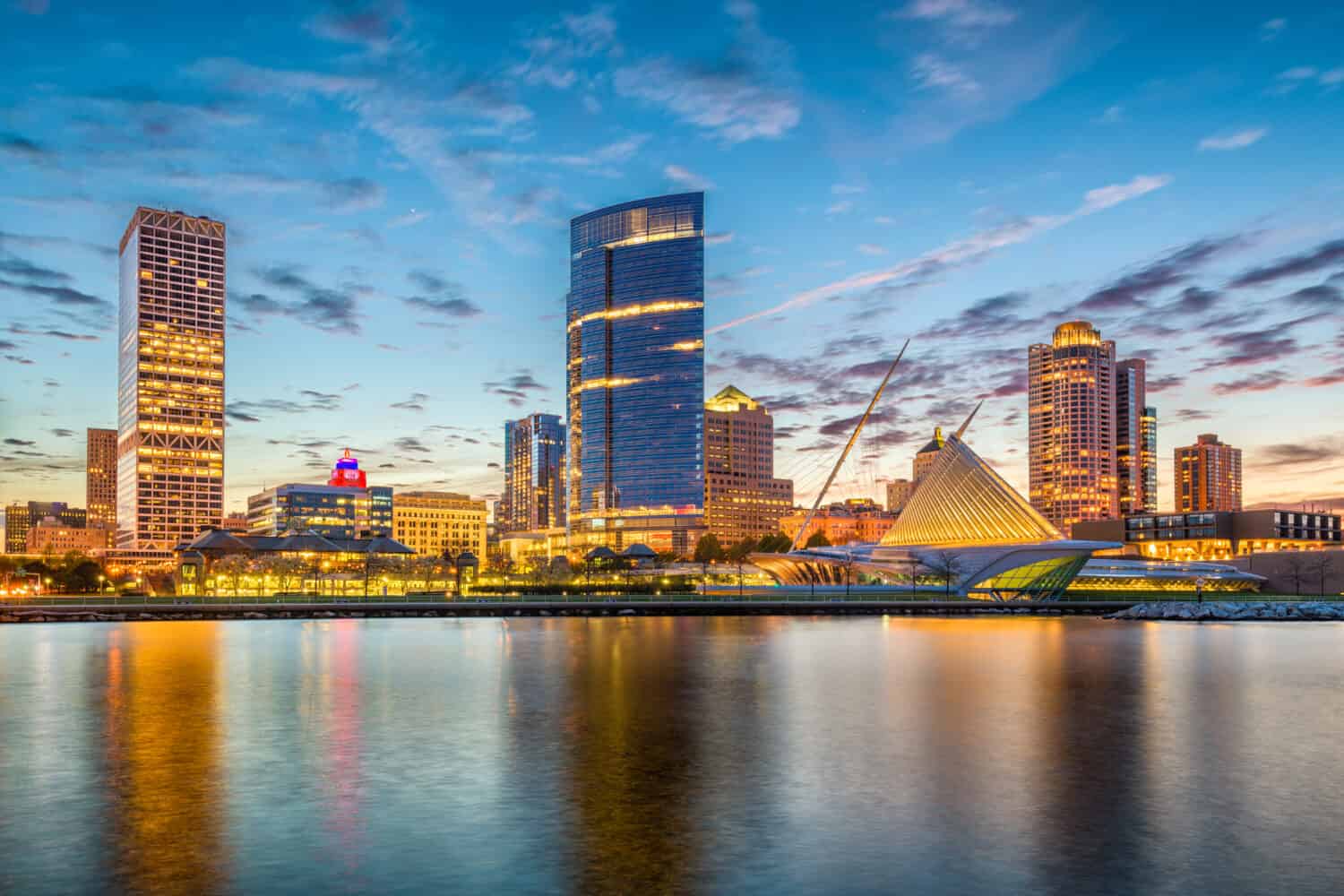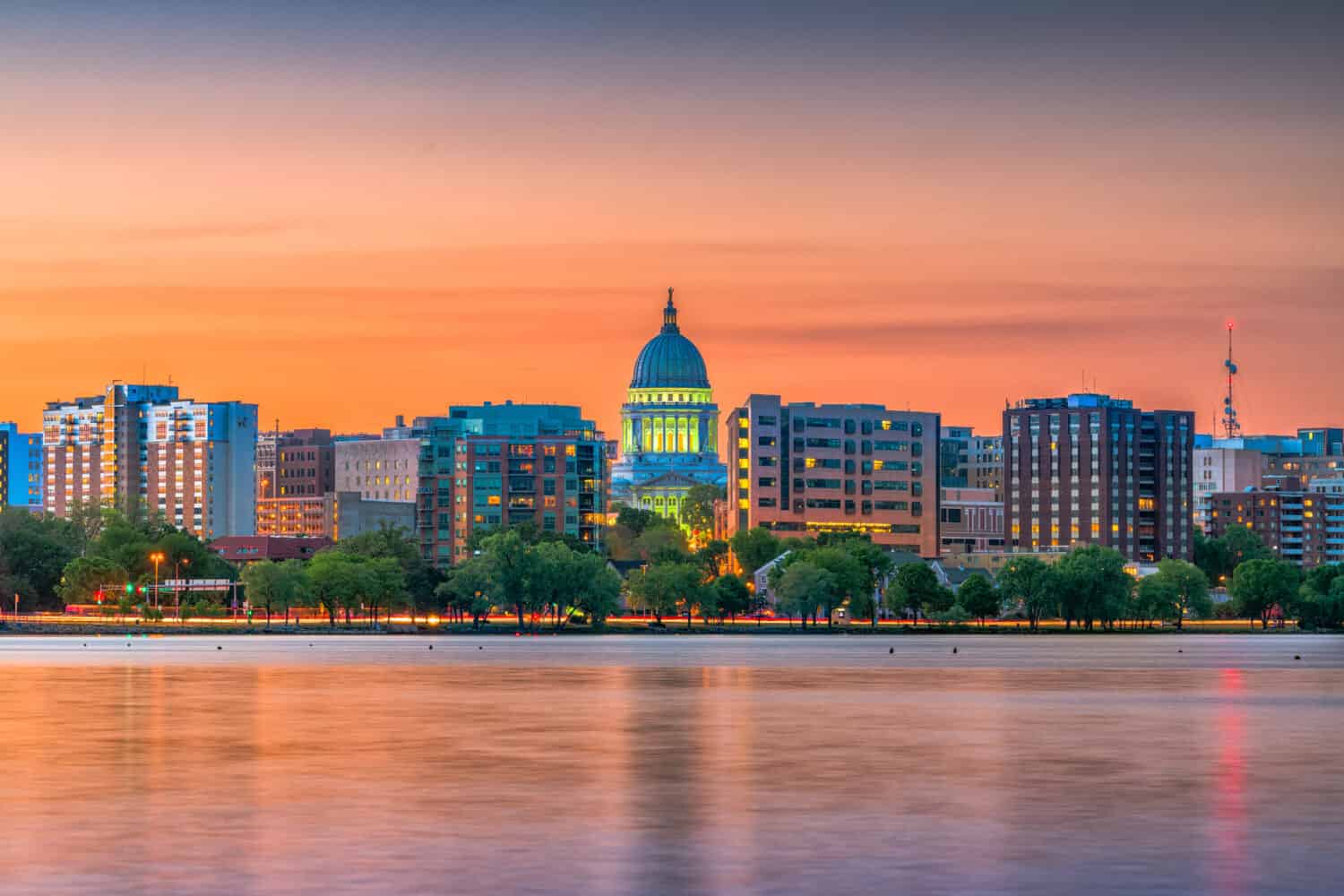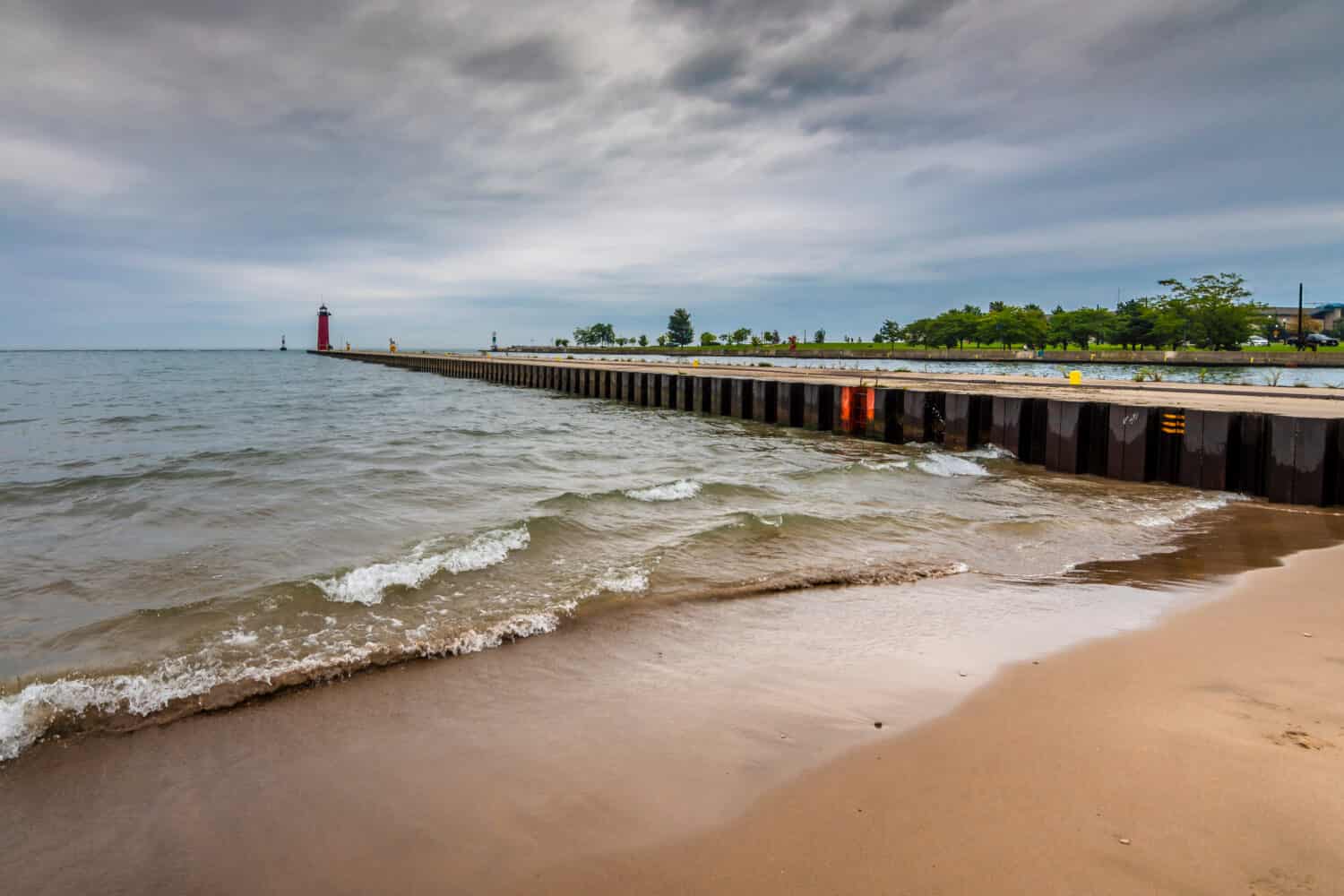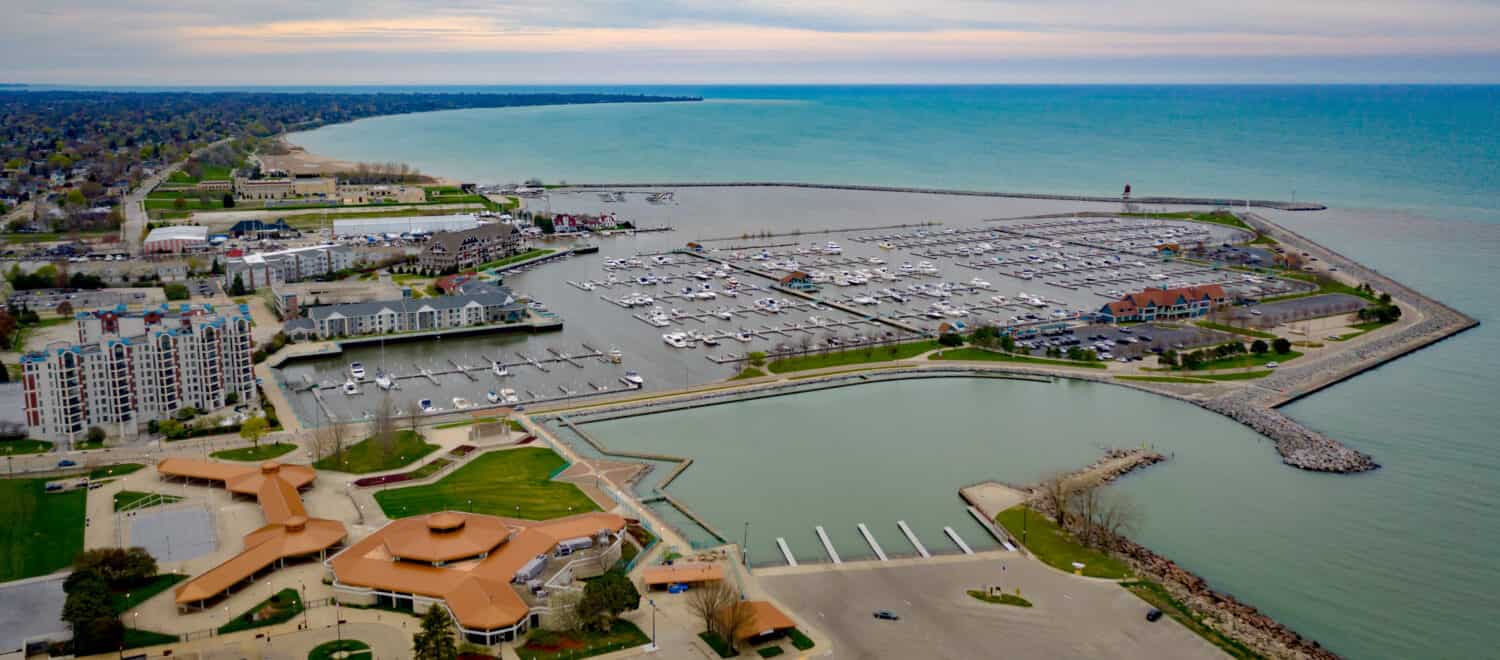Wisconsin has shores on both Lake Superior and Lake Michigan and is bordered to the west by the mighty Mississippi River. However, its interior is covered by agricultural fields and dense forests. It ranks 23rd for largest state by area and has a population of 5,893,718 residents, making it the 20th most populated state in the USA. This article will reveal the five largest Cities in Wisconsin by population, total area, and economic impact. Also, discover why people flock to these cities and their significance to the state.
The Largest Cities in the State Ranked by Population Size
| Rank | City | Population |
|---|---|---|
| 1 | Milwaukee | 598,078 |
| 2 | Madison | 239,848 |
| 3 | Green Bay | 104,574 |
| 4 | Kenosha | 99,709 |
| 5 | Racine | 78,347 |
Milwaukee

Milwaukee is the largest city in Wisconsin by population.
©Sean Pavone/Shutterstock.com
The population size of Milwaukee is around 598,078, with a population density of 6,178.5 per square mile. This is the largest city in Wisconsin, and it is located on the western shores of Lake Michigan. Best known for its beer history, with the Miller Brewing Company and smaller breweries providing jobs and attracting tourists. In fact, there are over 70 beer attractions and breweries across the Greater Milwaukee area, making it the foundation Milwaukee was built on. Another big draw to the city is the Harley-Davidson Museum, which has an excellent view of the Menomonee River and displays vintage motorbikes, including a 1956 KH owned by the King of Rock himself, Elvis.
Madison

Madison is the seat of Dane County and Wisconsin’s capital.
©Sean Pavone/Shutterstock.com
The population size of Madison is approximately 239,848, with a population density of 2,550.7 per square mile, making it the second-largest city in Wisconsin. Madison is the seat of Dane County and the state’s capital. Additionally, it is the home of the University of Wisconsin, the Overture Center for the Arts, and the Henry Vilas Zoo. Four lakes surround Madison:
- Lake Monona
- Lake Mendota
- Lake Kegonsa
- Lake Waubesa
Getting around Madison is easy with its extensive and well-connected public transport system. Lastly, this city is home to many museums, award-winning restaurants, arts and music venues and festivals, sporting events, and unique local shopping.
Green Bay

Green Bay is Wisconsin’s oldest settlement, dating to the 17th century.
©Jacob Boomsma/Shutterstock.com
The population size of Green Bay is around 104,574, with a population density of 1,869.0 per square mile, making it the third largest city in Wisconsin. This city serves as Brown County’s seat and sits on the southern tip of Lake Michigan’s Green Bay arm. It is Wisconsin’s oldest settlement, established in the 17th century.
This city is notorious for its football team, the Green Bay Packers, who are members of the National Football League. Furthermore, they host their home games at Lambeau Field in Green Bay. Additionally, there are several museums and historical attractions designed for history enthusiasts and families. However, the residents of Green Bay enjoy its delicious food, beautiful parks, gardens, and significant sports history. Lastly, this city receives many visitors from Chicago, Milwaukee, and Minneapolis, as it’s close enough for an exciting day trip.
Kenosha

Kenosha is situated between two major cities, Milwaukee and Chicago.
©Nejdet Duzen/Shutterstock.com
The city of Kenosha has a population of 99,709, with a population density of 3,688.7 per square mile, making it the fourth largest city in Wisconsin. This is a beautiful lakefront city on the shores of Lake Michigan. Kenosha is popular because it’s situated between two major cities, Milwaukee and Chicago. It also has a handful of bars, lakeside parks, museums, swimming areas, and restaurants. Furthermore, downtown is particularly exciting on weekends because there are usually music shows or small festivals, weather permitting. However, one of its main attractions is that over 90% of Kenosha’s waterfront on Lake Michigan is open to the public. Therefore, tourists flock to its beaches, bike and walking trails, parks, lighthouses, sculpture walk, and festival venues each year.
Racine

Racine is called “Belle City” for its beauty.
©Walter Leininger/Shutterstock.com
The population of Racine is 78,347, with a population density of 4,193.8 per square mile, making it the fifth largest city in Wisconsin. Racine serves as the seat of Racine County and sits on the shores of Lake Michigan at the mouth of the Root River. Due to its breathtaking scenery, this city earned the nickname Belle City, meaning “beautiful” in French. Racine lies between Chicago and Milwaukee, providing access to several entertainment options. In addition, this city is famous for its Danish sweets, specifically kringle, because it is home to the biggest Danish colony in North America (besides Greenland).
The Largest Cities in Wisconsin Ranked by Total Land Area
| Rank | City | Total Land Area |
|---|---|---|
| 1 | Milwaukee | 96.12 square miles |
| 2 | Madison | 76.79 square miles |
| 3 | Reserve | 53.01 square miles |
| 4 | Kronenwetter | 51.70 square miles |
| 5 | Mequon | 46.28 square miles |
Milwaukee
The city of Milwaukee has a total land area of 96.12 square miles. It boasts sculpted terrain by the glacier path, including steep bluffs along Lake Michigan. Furthermore, a few miles southwest of Milwaukee is the Lake Country and Kettle Moraine, which provides an industrial landscape mixed with inland lakes. The climate in Milwaukee varies greatly between seasons. For example, summers are warm, while winters get extremely cold, with plenty of wind and snow. The temperatures can range from 18 to 81 degrees Fahrenheit. So, the best time to visit the largest city in Wisconsin is from late June to mid-September. Additionally, this city offers a few notable natural attractions like Holy Hill, Hawthorn Glen Preserve, and Havenwoods State Forest.
Madison
The city of Madison has a total land area of 76.79 square miles. This city sits on an isthmus and lands surrounded by four lakes. The climate in Madison is warm and wet during the summers and freezing, windy, and snowy during the winters. Throughout the year, the temperature varies from 13 to 82 degrees Fahrenheit. However, the best time to visit this city is mid-June to early September. Besides the four lakes surrounding this city, another natural attraction is Cherokee Marsh, the largest wetland in Dane County.
Reserve
Located in northwest Wisconsin, Reserve has a total land area of 53.01 square miles and 0.68 square miles of water. Furthermore, the most pleasant months to visit this city is between June to August. This is when the temperatures range from 70 to 80 degrees Fahrenheit. However, July is the hottest month, with an average temperature of 80.2 degrees Fahrenheit. December is Reserve’s coldest month and usually receives 13.1 inches of snow. Additionally, this city typically receives seven months of snow yearly.
Kronenwetter
The city of Kronenwetter has a total land area of 51.70 square miles and is situated in Marathon County, approximately 5 miles from Waussau. Forests and agricultural land surround this city. Furthermore, the Wisconsin River borders the west side of Kronenwetter, and the city is surrounded by 10,000 acres of County Forest, which includes the Kronenwetter Forest unit. The climate in this city is warm and wet in the summer, while the winters are freezing, windy, and snowy. As a result, the temperature ranges from 8 to 80 degrees Fahrenheit. However, the best time to visit and enjoy all the water activities is from late June to late August.
Natural attractions include:
- Rib Mountain State Park
- Cave of Mounds
- Big Bass Lake
Mequon
While Mequon was incorporated as a city, about half of its land is still undeveloped, and agriculture is significant to the local economy. This city has warm summers and cold winters, with lots of snow and wind. As a result, the temperature varies from 17 to 80 degrees Fahrenheit. The best time to visit this city is between late June and early September. In addition, natural attractions include:
- Virmond Park
- Village Park
- Rotary Park
The Largest Cities in Wisconsin Ranked by Economic Impact
| City | Median Household Income |
|---|---|
| River Hills | $175,500 |
| Lac La Belle | $166,250 |
| Chenequa | $152,500 |
River Hills
A suburb of Milwaukee, River Hills has a population of 1,496. This village is ranked one of the best places to live in Wisconsin. Many residents of this quaint suburb are retired. Therefore, most people in this area own their homes. River Hills has a rural feel, but there are many coffee shops, restaurants, and parks.
Lac La Belle
The suburb of Lac La Belle in Milwaukee has a population of 244. This community is located in Jefferson County and is ranked one of Wisconsin’s best places to live. Most residents of this suburb are, and many people own their homes. Furthermore, the public schools in the area are rated very highly
Chenequa
The suburb of Chenequa in Milwaukee has a population of 777 and is ranked as one of Wisconsin’s best places to live. This picturesque suburb has a rural feel, and most residents are homeowners. Chenequa offers many parks and draws in an older crowd, as many residents are retired.
The photo featured at the top of this post is © DJ G/Shutterstock.com
Thank you for reading! Have some feedback for us? Contact the AZ Animals editorial team.






